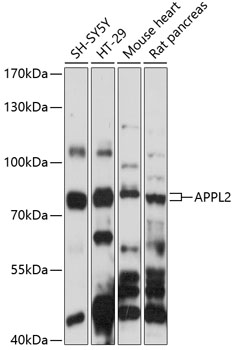Cell Cycle Antibodies 1
Anti-APPL2 Antibody (CAB14590)
- SKU:
- CAB14590
- Product Type:
- Antibody
- Reactivity:
- Human
- Reactivity:
- Mouse
- Reactivity:
- Rat
- Host Species:
- Rabbit
- Isotype:
- IgG
- Antibody Type:
- Polyclonal Antibody
- Research Area:
- Cell Cycle
Description
| Antibody Name: | Anti-APPL2 Antibody |
| Antibody SKU: | CAB14590 |
| Antibody Size: | 20uL, 50uL, 100uL |
| Application: | WB IHC |
| Reactivity: | Human, Mouse, Rat |
| Host Species: | Rabbit |
| Immunogen: | Recombinant fusion protein containing a sequence corresponding to amino acids 1-300 of human APPL2 (NP_060641.2). |
| Application: | WB IHC |
| Recommended Dilution: | WB 1:500 - 1:2000 IHC 1:50 - 1:100 |
| Reactivity: | Human, Mouse, Rat |
| Positive Samples: | SH-SY5Y, HT-29, Mouse heart, Rat pancreas |
| Immunogen: | Recombinant fusion protein containing a sequence corresponding to amino acids 1-300 of human APPL2 (NP_060641.2). |
| Purification Method: | Affinity purification |
| Storage Buffer: | Store at -20'C. Avoid freeze / thaw cycles. Buffer: PBS with 0.02% sodium azide, 50% glycerol, pH7.3. |
| Isotype: | IgG |
| Sequence: | MPAV DKLL LEEA LQDS PQTR SLLS VFEE DAGT LTDY TNQL LQAM QRVY GAQN EMCL ATQQ LSKQ LLAY EKQN FALG KGDE EVIS TLHY FSKV VDEL NLLH TELA KQLA DTMV LPII QFRE KDLT EVST LKDL FGLA SNEH DLSM AKYS RLPK KKEN EKVK TEVG KEVA AARR KQHL SSLQ YYCA LNAL QYRK QMAM MEPM IGFA HGQI NFFK KGAE MFSK RMDS FLSS VADM VQSI QVEL EAEA EKMR VSQQ ELLS VDES VYTP DSDV AAPQ INRN LIQK AGYL NLRN KTGL VTTT WERL |
| Gene ID: | 55198 |
| Uniprot: | Q8NEU8 |
| Cellular Location: | Early endosome membrane, Nucleus, Peripheral membrane protein |
| Calculated MW: | 69kDa/74kDa/75kDa |
| Observed MW: | 74kDa |
| Synonyms: | APPL2, DIP13B |
| Background: | The protein encoded by this gene is one of two effectors of the small GTPase RAB5A/Rab5, which are involved in a signal transduction pathway. Both effectors contain an N-terminal Bin/Amphiphysin/Rvs (BAR) domain, a central pleckstrin homology (PH) domain, and a C-terminal phosphotyrosine binding (PTB) domain, and they bind the Rab5 through the BAR domain. They are associated with endosomal membranes and can be translocated to the nucleus in response to the EGF stimulus. They interact with the NuRD/MeCP1 complex (nucleosome remodeling and deacetylase /methyl-CpG-binding protein 1 complex) and are required for efficient cell proliferation. A chromosomal aberration t(12;22)(q24.1;q13.3) involving this gene and the PSAP2 gene results in 22q13.3 deletion syndrome, also known as Phelan-McDermid syndrome. |
| UniProt Protein Function: | APPL2: a Rab5 effector protein that resides on a subpopulation of endosomes. Required for the regulation of cell proliferation in response to extracellular signals mediated by an early endosomal compartment. Links Rab5 to nuclear signal transduction. Its function requires Rab5 binding. Translocated into the nucleus upon release from endosomal membranes following internalization of EGF. Binds to subunits of the the nucleosome remodeling and deacetylase (NuRD) complex, an abundant and widely expressed deacetylase complex. The NURD complex contains both histone deacetylation and chromatin remodeling ATPase activities. Contains a PH domain and a phosphotyrosine interaction domain (PID) domain that has a structure similar to the insulin receptor substrate-1 PTB domain. |
| UniProt Protein Details: | Protein type:Adaptor/scaffold Chromosomal Location of Human Ortholog: 12q24.1 Cellular Component: cytoplasm; endosome membrane; nucleus; NuRD complex Molecular Function:protein binding Biological Process: cell proliferation; signal transduction |
| NCBI Summary: | The protein encoded by this gene is one of two effectors of the small GTPase RAB5A/Rab5, which are involved in a signal transduction pathway. Both effectors contain an N-terminal Bin/Amphiphysin/Rvs (BAR) domain, a central pleckstrin homology (PH) domain, and a C-terminal phosphotyrosine binding (PTB) domain, and they bind the Rab5 through the BAR domain. They are associated with endosomal membranes and can be translocated to the nucleus in response to the EGF stimulus. They interact with the NuRD/MeCP1 complex (nucleosome remodeling and deacetylase /methyl-CpG-binding protein 1 complex) and are required for efficient cell proliferation. A chromosomal aberration t(12;22)(q24.1;q13.3) involving this gene and the PSAP2 gene results in 22q13.3 deletion syndrome, also known as Phelan-McDermid syndrome. [provided by RefSeq, Oct 2011] |
| UniProt Code: | Q8NEU8 |
| NCBI GenInfo Identifier: | 160419148 |
| NCBI Gene ID: | 55198 |
| NCBI Accession: | Q8NEU8.3 |
| UniProt Secondary Accession: | Q8NEU8,Q8N4R7, Q9NVL2, B7Z411, B7Z4B0, F5GZG0, F8W1P5 |
| UniProt Related Accession: | Q8NEU8 |
| Molecular Weight: | 75,184 Da |
| NCBI Full Name: | DCC-interacting protein 13-beta |
| NCBI Synonym Full Names: | adaptor protein, phosphotyrosine interacting with PH domain and leucine zipper 2 |
| NCBI Official Symbol: | APPL2 |
| NCBI Official Synonym Symbols: | DIP13B |
| NCBI Protein Information: | DCC-interacting protein 13-beta |
| UniProt Protein Name: | DCC-interacting protein 13-beta |
| UniProt Synonym Protein Names: | Adapter protein containing PH domain, PTB domain and leucine zipper motif 2 |
| Protein Family: | DCC-interacting protein |
| UniProt Gene Name: | APPL2 |
| UniProt Entry Name: | DP13B_HUMAN |
View AllClose







